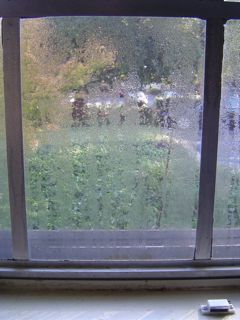Why Is Fall a Good Time of Year for Window Condensation?

 If you live in an older house with inefficient, single-pane windows, you may have noticed water condensing on the inside surface of the glass lately. Fall happens to be a pretty good time for that to happen. Do you know why your windows are crying? I mean, besides the fact that they’re sad for you because of all the heat that goes through them.
If you live in an older house with inefficient, single-pane windows, you may have noticed water condensing on the inside surface of the glass lately. Fall happens to be a pretty good time for that to happen. Do you know why your windows are crying? I mean, besides the fact that they’re sad for you because of all the heat that goes through them.
If you live in an older house with inefficient, single-pane windows, you may have noticed water condensing on the inside surface of the glass lately. Fall happens to be a pretty good time for that to happen. Do you know why your windows are crying? I mean, besides the fact that they’re sad for you because of all the heat that goes through them.
Let’s work backwards, and see if we can figure it out.
Fact: There’s water on the glass.
Question: Where did it come from?
Possibilities: (a) The water came from outside and passed through the glass by diffusion. (b) The water came from the glass itself. (c) The water came from the air inside the house.
If you chose (c), you’re correct. The air inside the house has moisture in it. We call that moisture in the air humidity. The absolute amount of humidity in the air determines at what temperature condensation happens. That temperature is called the dew point, and I like using dew point as a measure of moisture in air more than the quantity we usually use: relative humidity.
OK, so the air has moisture. That moisture-laden air has a dew point. For condensation to happen, the air has to find a surface at or below the dew point. Pretty simple, right? The glass is cold and collects condensation.
But why don’t you see condensation on your windows as often in the winter or spring as you do in the fall? Well, maybe you do for other reasons (like unvented gas space heaters), but many older houses with single-pane windows see more condensation in the fall.
Remember, condensation depends on two things: A surface with a low temperature and air with a dew point temperature higher than the surface temperature. Those windows are going to stay cold through the winter and spring, but what changes is the amount of moisture in the air.
In fall, a house in a humid climate is coming off a summer full of humidity. Even with air conditioning, moisture gets into the house and many of the sorptive materials in the house will suck up a lot of water. In fall, as cooler, drier air surrounds the outside of the house and gets inside, those materials start giving up their moisture load, but it takes a while. By winter, the house has dried out, so even with low window temperatures, you don’t get condensation, but in fall, there’s still plenty of moisture in the air.
There are two ways to reduce or eliminate window condensation:
- Raise the window temperature.
- Reduce the humidity of the air inside the house.
Installing more efficient windows or storm windows helps by keeping the temperature of your windows closer to the indoor temperature, making it more likely that they’re above the dew point. Keeping your humidity lower through the summer and fall will help also by lowering the dew point of the air. Making sure you don’t have an oversized air conditioner will help with that.
Related Articles
Dew Point — A More Meaningful Measure of Humidity?
Window Condensation – Moisture Problems & Energy Conservation
This Post Has 4 Comments
Comments are closed.

Nice post.
Nice post.
I love the word sorptive/sorption.
I especially like “adsorption”. Though it bugs me whenever I use it and people correct me. “You mean ‘absorption’. Right?” 🙂
John P.:
John P.: Thanks! I guess it’s a science thing. My freshman chemistry book had a great cartoon illustrating the difference between absorption and adsorption. It showed a man and a pie in each case.
Here in PA this year we are
Here in PA this year we are seeing water condensed on the outside of our double pane casement windows most mornings. There is about half an inch of clear glass around the edges of the glass where the “warm” spacers between the two panes are not really providing a thermal break between the warm inside pane and the cold outside pane. That uniform coating of condensation gives you a good lesson on the value of better quality windows.
Another contributing factor
Another contributing factor is the difference is how drafty the old windows were and how airtight the new ones are…